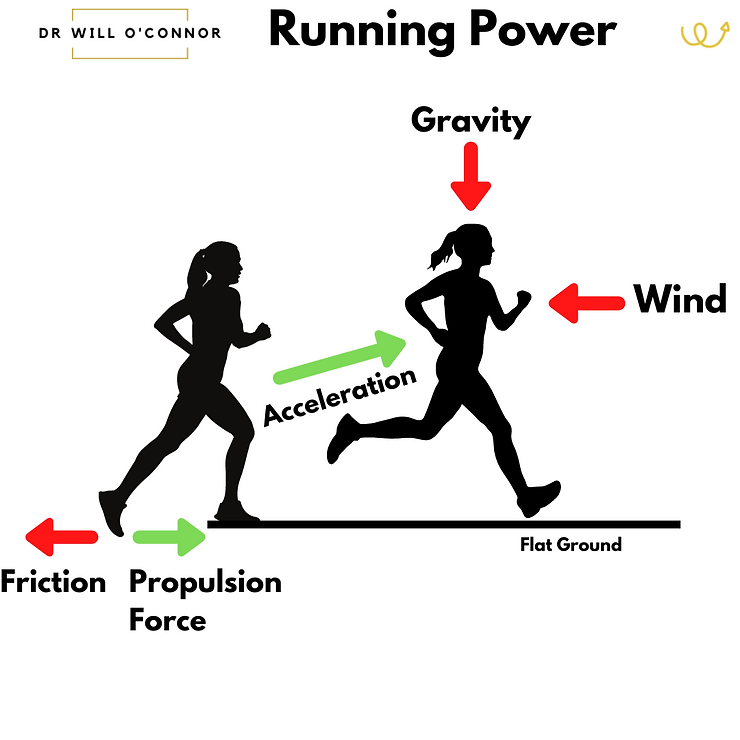Spending $200usd on a piece of kit that isn’t shoes and isn’t a watch is an outrageous proposition to any runner. In fact, I recall being ridiculed for buying a GPS watch (Garmin 405) in 2010! Over the last decade, runners have accepted GPS devices and understood their true value – uploading to Strava and proving every race they do is a few hundred meters/yards long.
Joking aside, GPS and subsequently heart rate monitors have found their way onto the wrists of almost all runners and most, if not all, coaches have an understanding of how to effectively use both pace and heart rate to create faster runners. However, there are shortfalls associated with both pace and heart rate, and that is why power has been introduced to the running the marketplace.
Running power, WTF is it?
Power is the rate of doing work. Work (kilojoules) = the amount of energy needed to run. The faster you run the more work you need to do and the more energy you utilize.
Currently, most runners are monitoring their efforts by measuring how fast they’re moving (pace, min/km or min/mi) and/or how fast their heart is beating; heart rate (bpm).
By measuring the amount of work you are doing at any given time, you can get a more accurate measurement of your effort.
Issues with the Status Quo
GPS – A Measurement From Space
Gravity and Accuracy.
Gravity
How fast should you run up a hill? The answer depends on a multitude of factors; gradient, distance, terrain, position within the race, your weight, the list goes on. In short, we’re throwing blind darts when it comes to gauging our effort on uphills. Yes, you can substitute pace with heart rate, but as you’ll see below, heart rate has its issues too.
Accuracy
If you’re running on trails or in a city with tall buildings chances are your GPS will not be accurate. The fastest sampling rate, how often a GPS coordinate is taken, on most watches is 1 sec, and that’s with a clear line of sight. Switchbacks, right-angle turns, and U-turns can add to the inaccuracy of GPS. If you’ve run 1km in 4min, but your watch has measured 950m your pace will read 4:13min/km. A change of such magnitude (5%) can drastically affect your pacing strategy.
Heart Rate – The Dial-up Broadband of Metrics
When measuring your heart rate, there is a delay between the work you do and your cardiovascular response. It’s referred to as the oxygen (O2) slow component. (more in our Masterclass). At the start of an effort or race, your HR will be low to reflect the low amount of work you’re doing, i.e. standing on the start line. Once you start your race, it will take a few minutes for your HR to respond (during this time there is a higher reliance on anaerobic energy production). It usually takes around 3-5 minutes to reach a steady-state in both HR and oxygen consumption. At this time, HR is not reflective of the work being done, and it’s not possible to accurately measure the effort.
How is Running Power Different?
Running Power Explained
Running requires you to overcome gravity, wind, and friction to move forward (figure 1). When you push off the ground you must travel upwards and forwards. The distance you travel is relative to the amount of force you applied to the ground, your body weight, the gradient you’re running and how windy it is.
A running power meter is measuring all of the components required to run using accelerometers. GPS on the other hand is simply measuring how fast you are moving by tracking your location and calculating how long it takes you to move between two points; your speed/pace.
Running power meters aren’t reliant on GPS, so they are able to more accurately measure the distance you travel per stride. Not only that but because running power meters are built with barometers they give you an indication of your efforts on uphills and downhills.
Running power is an estimation of work done and thus power output. In running we are calculating power P from your body weight (mass, m), your acceleration (a, m/s2) and the speed (velocity, m/s) using the formula: P = F*v and F = m*a.
In cycling, the more power the better. If you produce more power in running it won’t directly translate into speed. In running, you want to use less power for a given speed. The less power you use to run a certain speed the more efficient you are. More power doesn’t always correlate with faster speeds, and it’s possible that you are actually wasting energy which can be measured by running effectiveness. You can only measure running effectiveness using a power meter.
Running power is calculated using a boatload of metrics; weight, height, running speed, elevation, ground contact time, vertical oscillation, wind resistance.
Using all of these important components of running, you’re able to track your training and plan your races more efficiently.
In Part Two, I’ll go over how to train with power.







